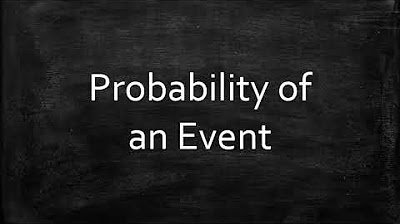Tossing an Unfair Coin
Summary
TLDRThis video script explores the concept of tossing an unfair coin, contrasting it with a fair coin. It explains how to calculate probabilities of heads and tails given different odds, using examples like tails being three times more likely than heads. The script then discusses the sample space of coin tosses, calculating probabilities of various outcomes using the special multiplication rule. It concludes by applying these concepts to find the probability of getting six heads in ten tosses, emphasizing the practical applications of these calculations in modeling real-life experiments.
Takeaways
- 🎲 An unfair coin has outcomes that are not equally likely, unlike a fair coin where both outcomes have a probability of one half.
- 📊 The probability of each outcome in an unfair coin is unknown unless specified, such as tails being three times more likely than heads.
- 🔢 If tails are three times more likely than heads, the probability of tails is 0.75 and heads is 0.25.
- 📉 Conversely, if tails are four times less likely than heads, the probability of tails is 0.20 and heads is 0.80.
- 🧮 The sample space for tossing a coin multiple times can be calculated using probabilities of heads (p) and tails (q).
- 🔄 The outcomes of different tosses are independent, so the probability of four heads is p^4.
- 📚 The probability of a simple outcome depends only on the number of heads and tails in the outcome.
- 🔢 The probability of having zero heads among four tosses is q^4, and one head is 4pqqq, following the special addition rule.
- 📐 The formula for the probability of having k heads among n tosses is given by a specific formula, which can be used without listing all simple outcomes.
- 🎯 For an unfair coin where heads are seven times likelier than tails, the probability of getting six heads in ten tosses is calculated to be 2.3%.
- 🔄 The formula for an unfair coin simplifies to that of a fair coin when the probability of heads and tails is equal to one half.
Q & A
What is an unfair coin?
-An unfair coin is one where the outcomes of heads and tails are not equally likely, meaning the probabilities of each outcome are not both equal to 0.5.
How are the outcomes of a fair coin different from an unfair coin?
-In a fair coin, the outcomes are equally likely, with each outcome having a probability of 0.5. In contrast, an unfair coin has outcomes with different probabilities, which are not equal.
If tails are three times more likely than heads, what are the probabilities of tails and heads?
-If tails are three times more likely than heads, the probability of tails is 0.75 and the probability of heads is 0.25.
What does it mean if tails are four times less likely than heads?
-If tails are four times less likely than heads, it means the odds in favor of tails are one to four, so the probability of tails is 20% (0.20) and the probability of heads is 80% (0.80).
How can you calculate the probability of getting four heads when tossing a coin four times if heads have a probability (p)?
-The probability of getting four heads is calculated as (p^4), assuming the tosses are independent.
What is the special multiplication rule mentioned in the transcript?
-The special multiplication rule refers to the process of finding the probability of multiple independent events occurring in sequence by multiplying the probabilities of each event.
How is the probability of getting a certain number of heads among a certain number of coin tosses calculated?
-The probability of getting k heads among n tosses is given by the formula which considers the number of ways to choose k heads from n tosses, multiplied by the probability of heads raised to the power of k, and the probability of tails raised to the power of (n-k).
What are the coefficients in the probability expressions when tossing a coin multiple times?
-The coefficients in the probability expressions are the number of ways to arrange k heads in n tosses, which can be found using combinations.
How can you find the probability of getting two heads among four tosses without listing all outcomes?
-You can find the probability of getting two heads among four tosses by using the formula that considers the combinations of getting two heads in four tosses, which is 4C2 * (p^2) * (q^2).
If heads are seven times likelier than tails, what is the probability of getting six heads in ten tosses?
-If heads are seven times likelier than tails, the probability of getting six heads in ten tosses is calculated using the formula for binomial probability with p = 7/8 and q = 1/8, resulting in a probability of approximately 2.3%.
What happens to the formula for an unfair coin if the probability of heads and tails is equal to 1/2?
-If the probability of heads and tails is equal to 1/2, the formula for an unfair coin simplifies to the formula for a fair coin, where each outcome has an equal chance of occurring.
Outlines

このセクションは有料ユーザー限定です。 アクセスするには、アップグレードをお願いします。
今すぐアップグレードMindmap

このセクションは有料ユーザー限定です。 アクセスするには、アップグレードをお願いします。
今すぐアップグレードKeywords

このセクションは有料ユーザー限定です。 アクセスするには、アップグレードをお願いします。
今すぐアップグレードHighlights

このセクションは有料ユーザー限定です。 アクセスするには、アップグレードをお願いします。
今すぐアップグレードTranscripts

このセクションは有料ユーザー限定です。 アクセスするには、アップグレードをお願いします。
今すぐアップグレード関連動画をさらに表示

Tossing a Fair Coin

Experimento Aleatorio, Espacio Muestral, Evento o Suceso y Probabilidades

Probability of an Event

What is Probability? (GMAT/GRE/CAT/Bank PO/SSC CGL) | Don't Memorise

Bien rédiger un exercice contenant la loi binomiale. Bernoulli. Probabilité.Terminale.

Menentukan Peluang Empirik Frekuensi Relatif dari Suatu Kejadian
5.0 / 5 (0 votes)
